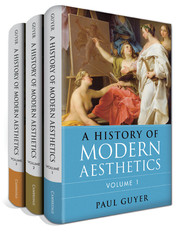Book contents
- Volume 1 The Eighteenth Century
- Frontmatter
- Epigraph
- Contents
- Acknowledgments
- Introduction
- 1 Prologue
- Part One Aesthetics in Britain, 1725–1800
- Part Two French Aesthetics in Mid-Century
- Part Three German Aesthetics between Wolff and Kant
- Part Four Kant and After
- Bibliography
- Index
- Volume 2 The Nineteenth Century
- Volume 3 The Twentieth Century
- References
1 - Prologue
The Origins of Modern Aesthetics
from Volume 1 - The Eighteenth Century
Published online by Cambridge University Press: 05 June 2015
- Volume 1 The Eighteenth Century
- Frontmatter
- Epigraph
- Contents
- Acknowledgments
- Introduction
- 1 Prologue
- Part One Aesthetics in Britain, 1725–1800
- Part Two French Aesthetics in Mid-Century
- Part Three German Aesthetics between Wolff and Kant
- Part Four Kant and After
- Bibliography
- Index
- Volume 2 The Nineteenth Century
- Volume 3 The Twentieth Century
- References
Summary
The idea of the disinterestedness of pleasure in the beautiful, analogous to the disinterestedness of moral sentiment, was introduced by the Earl of Shaftesbury in his dialogue The Moralists. Many have held the idea of disinterestedness to be the defining idea or at least one of the central ideas of modern aesthetics. I do not share the judgment that the disinterestedness of pleasure in beauty or of the contemplation that produces it was the most important concept of the aesthetics of the eighteenth century, or even widely accepted, but I will nevertheless take Shaftesbury’s work, first published in 1709 and then republished in his Characteristicks of Men, Manners, Opinions, and Times in 1711, as the starting point for eighteenth-century aesthetics; the tremendous influence of this work throughout the century, not only in Britain, but also in France and Germany, justifies its assignment to this position, even if the disinterestedness of aesthetic response and judgment was by no means the lesson that all its readers drew from it. The greatest contribution of the work was rather its recognition of the importance of feeling or sentiment in human consciousness and conduct, the basis for its seminal role in eighteenth-century moral theory as well as aesthetics. But Shaftesbury by no means simply opposed sentiment to reason, as later “moral sense” theorists such as David Hume did. On the contrary, Shaftesbury linked the sentiment of pleasure in beauty to apprehension of the rational order of creation and the reason of its ultimate creator. In treating aesthetic sentiment as ultimately an apprehension of rational order, Shaftesbury thus took a fundamentally cognitivist approach to aesthetic experience in spite of his emphasis on sentiment as foremost in the phenomenology of such experience.
- Type
- Chapter
- Information
- A History of Modern Aesthetics , pp. 30 - 94Publisher: Cambridge University PressPrint publication year: 2014



